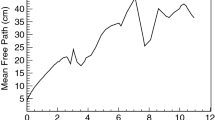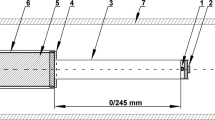Abstract
The necessity to monitor international commercial transportation for illicit nuclear materials resulted in the installation of many nuclear radiation detection systems in Portal Monitors. To overcome the difficulty of innocent alarms due to a large content of natural radioactivity or medical nuclides, Department of Homeland Security (DHS) supported the writing of the ANSI N42.38 standard (Performance Criteria for Spectroscopy-Based Portal Monitors used for Homeland Security) to define the performance of a portal monitor with nuclide identification capabilities, called a Spectroscopy Portal Monitor. To accomplish the necessary performance, several different HPGe detector configurations were modeled using MCNP for the horizontal field of view (FOV) and vertical linearity of response over the detection zone of 5 meters by 4.5 meters for 661 keV as representative of the expected nuclides of interest. The configuration with the best result was built and tested. The results for the FOV as a function of energy and the linearity show good agreement with the model and performance exceeding the requirements of N42.38.
Similar content being viewed by others
References
B. Rooney, On Detecting nuclear weapons and radiological materials: How effective is available technology?, Report to the Subcommittee on Prevention of Nuclear and Biological Attacks and the Subcommittee on Emergency Preparedness, Science and Technology of the House Committee on Homeland Security, June 21, 2005.
ANSI N42.38, Performance Criteria for Spectroscopy-Based Portal Monitors used for Homeland Security, American National Standards Institute, 2006.
MCNP, A General Monte Carlo N-Particle Transport Code, available from Radiation Safety Information Computational Center, ORNL, Oak Ridge, TN.
R. M. Keyser, W. K. Hensley, Efficiency of Germanium Detectors as a Function of Energy and Incident Geometry: Comparison of Measurements and Calculations, MARC VI, Kona, HI, 2003.
H. L. Beck et al., In Situ Ge(Li) and NaI(Tl) Gamma Ray Spectrometry, U.S. Department of Energy, Environmental Measurements Laboratory, HASL-258, September 1972.
I. K. Helfer, K. M. Miller, Health Phys., 55 (1988) 15.
IEEE 325-2006, IEEE Standard Test Procedures for Germanium Gamma-Ray Detectors Used in Analog and Digital Signal Processing Systems, IEEE Standards Association, 445 Hoes Lane, Piscataway, New Jersey 08855-1331.
Author information
Authors and Affiliations
Corresponding author
Rights and permissions
About this article
Cite this article
Keyser, R.M., Hensley, W., Twomey, T.R. et al. Comparison of MCNP and experimental measurements for an HPGe-based spectroscopy portal monitor. J Radioanal Nucl Chem 276, 399–405 (2008). https://doi.org/10.1007/s10967-008-0518-9
Received:
Published:
Issue Date:
DOI: https://doi.org/10.1007/s10967-008-0518-9




